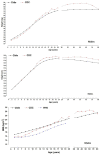Comparison of Anthropometric Indicators That Assess Nutritional Status From Infancy to Old Age and Proposal of Percentiles for a Regional Sample of Chile
- PMID: 35004795
- PMCID: PMC8740328
- DOI: 10.3389/fnut.2021.657491
Comparison of Anthropometric Indicators That Assess Nutritional Status From Infancy to Old Age and Proposal of Percentiles for a Regional Sample of Chile
Abstract
Objectives: Anthropometric variables are used to evaluate health, dietary status, disease risks, and changes in body composition. The purpose of this study was to compare weight, height, and Body Mass Index (BMI) with American references from the National Center for Health Statistics (NCHS-2012), using BMI and Tri-Ponderal Mass Index (TMI) to propose percentiles for evaluating nutritional status of children, adolescents, and adults, ages 5-80 years old. Methods: A descriptive cross-sectional study was conducted in 15,436 (8,070 males and 7,366 females) children, youths and adults in the Maule region (Chile). The age range ranged from 5.0 to ~80 years of age. Weight and height were assessed. Body mass index BMI and tri-ponderal mass index (TMI) were calculated. The LMS method was used to generate percentiles. Results: The results illustrated that children were heavier and had more BMI during childhood compared to the NCHS references. During adolescence, reference values were greater until approximately ages 70-79. For height, children were relatively similar to those of the NCHS references, but during adolescence, differences became evident. Adolescence until approximately age 80, the population showed lower values for height. Percentiles were calculated using BMI and TMI by age range and sex. Differences occurred between the American NCHS references and the population with regard to the anthropometric variables of weight, height, and in BMI. Conclusion: Discrepancies with the American NCHS reference were verified in the anthropometric variables of weight, height and BMI. Reference percentiles of BMI and TMI were developed for the evaluation of the nutritional status of the regional population of Maule (Chile). Its use is suggested in clinical and epidemiological contexts.
Keywords: adolescents; adults; children; nutritional state; percentiles.
Copyright © 2021 Gómez-Campos, Vidal-Espinoza, Marques de Moraes, Lázari, Andruske, Castelli Correia de Campos, Urzua-Alul, Cossio-Bolaños and Cossio-Bolanõs.
Conflict of interest statement
The authors declare that the research was conducted in the absence of any commercial or financial relationships that could be construed as a potential conflict of interest.
Figures



Similar articles
-
Tri-Ponderal Mass Index vs Body Mass Index in Estimating Body Fat During Adolescence.JAMA Pediatr. 2017 Jul 1;171(7):629-636. doi: 10.1001/jamapediatrics.2017.0460. JAMA Pediatr. 2017. PMID: 28505241 Free PMC article.
-
Physical Growth and Body Adiposity Curves in Students of the Maule Region (Chile).Front Pediatr. 2019 Aug 6;7:323. doi: 10.3389/fped.2019.00323. eCollection 2019. Front Pediatr. 2019. PMID: 31448248 Free PMC article.
-
[Proposal of percentiles to evaluate physical growth and body adiposity as a function of maturity status in Chilean children and adolescents].Nutr Hosp. 2021 Oct 13;38(5):935-942. doi: 10.20960/nh.03563. Nutr Hosp. 2021. PMID: 34034502 Spanish.
-
Height, weight and BMI percentiles and nutritional status relative to the international growth references among Pakistani school-aged children.BMC Pediatr. 2012 Mar 19;12:31. doi: 10.1186/1471-2431-12-31. BMC Pediatr. 2012. PMID: 22429910 Free PMC article.
-
Tri-Ponderal Mass Index as a Screening Tool for Identifying Body Fat and Cardiovascular Risk Factors in Children and Adolescents: A Systematic Review.Front Endocrinol (Lausanne). 2021 Oct 21;12:694681. doi: 10.3389/fendo.2021.694681. eCollection 2021. Front Endocrinol (Lausanne). 2021. PMID: 34744995 Free PMC article.
References
-
- World Health Organization (WHO) . Improvement of Nutritional Status of Adolescents (2002). Available online at: http://apps.searo.who.int/pds_docs/B3526.pdf (accessed February 5, 2014)
-
- Dwyer JT, Gallo JJ, Reichel W. Assessing nutritional status in elderly patients. Am Fam Physician. (1993) 47:613–20. - PubMed
-
- Simko MD, Cowell C, Gilbride JA. Nutrition Assessment: A Comprehensive Guide for Planning Intervention. 2nd ed. Gaithersburg, MD: Aspen Publishers; (1995).
LinkOut - more resources
Full Text Sources

